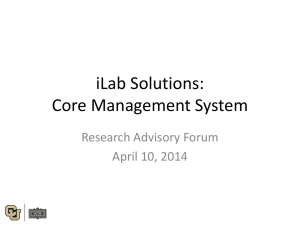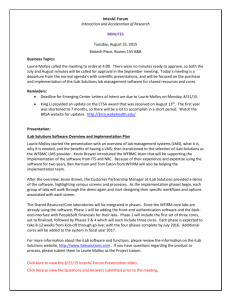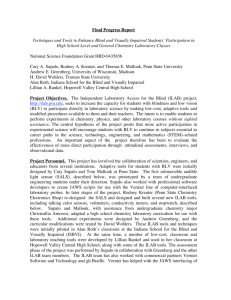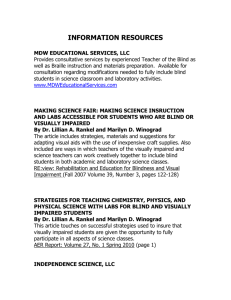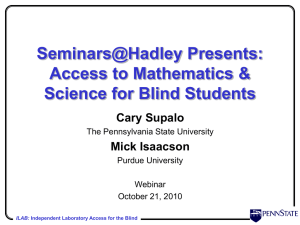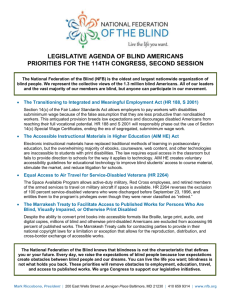Summary of Research Progress, CHE-0095394 - Faculty
advertisement
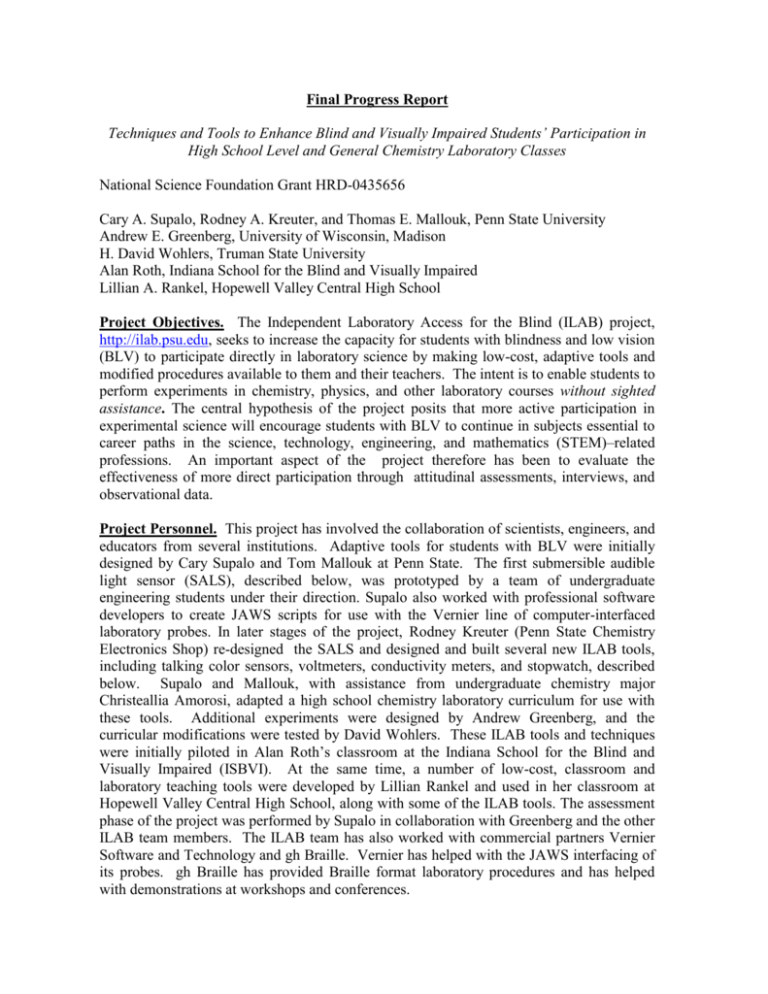
Final Progress Report Techniques and Tools to Enhance Blind and Visually Impaired Students’ Participation in High School Level and General Chemistry Laboratory Classes National Science Foundation Grant HRD-0435656 Cary A. Supalo, Rodney A. Kreuter, and Thomas E. Mallouk, Penn State University Andrew E. Greenberg, University of Wisconsin, Madison H. David Wohlers, Truman State University Alan Roth, Indiana School for the Blind and Visually Impaired Lillian A. Rankel, Hopewell Valley Central High School Project Objectives. The Independent Laboratory Access for the Blind (ILAB) project, http://ilab.psu.edu, seeks to increase the capacity for students with blindness and low vision (BLV) to participate directly in laboratory science by making low-cost, adaptive tools and modified procedures available to them and their teachers. The intent is to enable students to perform experiments in chemistry, physics, and other laboratory courses without sighted assistance. The central hypothesis of the project posits that more active participation in experimental science will encourage students with BLV to continue in subjects essential to career paths in the science, technology, engineering, and mathematics (STEM)–related professions. An important aspect of the project therefore has been to evaluate the effectiveness of more direct participation through attitudinal assessments, interviews, and observational data. Project Personnel. This project has involved the collaboration of scientists, engineers, and educators from several institutions. Adaptive tools for students with BLV were initially designed by Cary Supalo and Tom Mallouk at Penn State. The first submersible audible light sensor (SALS), described below, was prototyped by a team of undergraduate engineering students under their direction. Supalo also worked with professional software developers to create JAWS scripts for use with the Vernier line of computer-interfaced laboratory probes. In later stages of the project, Rodney Kreuter (Penn State Chemistry Electronics Shop) re-designed the SALS and designed and built several new ILAB tools, including talking color sensors, voltmeters, conductivity meters, and stopwatch, described below. Supalo and Mallouk, with assistance from undergraduate chemistry major Christeallia Amorosi, adapted a high school chemistry laboratory curriculum for use with these tools. Additional experiments were designed by Andrew Greenberg, and the curricular modifications were tested by David Wohlers. These ILAB tools and techniques were initially piloted in Alan Roth’s classroom at the Indiana School for the Blind and Visually Impaired (ISBVI). At the same time, a number of low-cost, classroom and laboratory teaching tools were developed by Lillian Rankel and used in her classroom at Hopewell Valley Central High School, along with some of the ILAB tools. The assessment phase of the project was performed by Supalo in collaboration with Greenberg and the other ILAB team members. The ILAB team has also worked with commercial partners Vernier Software and Technology and gh Braille. Vernier has helped with the JAWS interfacing of its probes. gh Braille has provided Braille format laboratory procedures and has helped with demonstrations at workshops and conferences. 2 ILAB Electronic Tools Submersible Audible Light Sensor (SALS). The SALS is a battery-powered device that registers color change or precipitate formation in real time with sound. The design is userfriendly, with talking controls and output, and is also cost effective (parts and labor cost $50-100, depending on the number of units produced). The SALS is based on a photocell that measures light intensity changes. The photocell is encased in a transparent “wand” that is small enough to allow measurements to be made in ordinary test tubes or beakers. The test tube or beaker is placed over a light box or a white reflective surface such as a piece of printer paper, as illustrated in Figure 1. As a reaction proceeds, the varying light intensity at the tip of the sensor wand is converted electronically to an audible tone. The chemical change (e.g., how cloudy or dark the solution becomes) is indicated by a more pronounced change in pitch, usually from high to low. The SALS control box has a memory function that allows reference and data pitches to be stored. It can output these pitches directly or as spoken frequency values. Fig. 1. Monitoring a color change in a chemical reaction using the SALS and a light box. Many of the experiments done in the general chemistry laboratory (titrations, qualitative analysis of solutions, oxidation-reduction, precipitation, flame tests) involve visual observations. Experiments from the Prentice Hall Chemistry Laboratory Manual (2005) were used as a representative set of experiments for adaptation with the SALS. The performance of the SALS was tested in detail by using one of these experiments, the iodine clock reaction. In this reaction, a starch-iodine indicator signals the changes that occur as an oxidation-reduction reaction proceeds. The times at which these relatively abrupt changes occur depend on the initial concentrations of reagents. The reaction involves sequential changes from colorless to blue, green, brown, and ultimately black, corresponding to an absorbance that appears initially in the red spectral region at about 600 nm and then gradually shifts to cover the entire visible spectrum. The tone output from the SALS changes by more than one octave over the 1-2 minute course of the reaction. In this adaptation of the Addison-Wesley experiment, a test tube is held by a test tube rack above a light box, with the SALS probe immersed in the solution as shown in Fig. 1. This reaction 3 can be performed while using a talking timer (see below) in order to record the times at which the color changes occur. The SALS control box can also be fitted with a simple conductivity probe that allows it to detect the conductivity difference between two solutions, for example aqueous and non-aqueous layers in a separatory funnel. This allows the student in an organic chemistry experiment to use the separatory funnel, detecting the point at which the more dense solution has passed completely through the stopcock at the bottom. Figure 2 shows the conductivity probe attached to a 25 mL volumetric pipette, which can be immersed into the separatory funnel. This apparatus was developed for a biodiesel synthesis/separation experiment, which was performed by 20 high school students at the National Federation of the Blind (NFB) Youth Slam in summer 2007. Fig. 2. A simple ionic conductivity probe (consisting of two insulated wires, exposed at the tip with a gap between them) can be used with the SALS controller box to convert conductivity to audible pitch. Fig. 3. The CALS controller box with the test tube probe (left) and solids probe (right). Color Analysis Laboratory Sensor (CALS). The CALS has similar talking controls to the SALS. It can report the color of a solution or solid, either as a spoken color, or as numerical red-blue-green (RGB) and total light readings. The device is calibrated by holding the sensor up to a piece of white paper. Unlike the SALS, the CALS does not report values continuously, but speaks the color or gives the RGB reading 1-2 seconds after the appropriate button has been pushed. Fig. 3 shows the CALS with test tube and solids probes, which plug into the same port on the battery-powered, talking controller box. The test tube probe, which determines the color of light transmitted through a solution, gives very accurate color readings. The solids probe uses reflected light and is less accurate, 4 confusing for example red and pink, or brown and yellow. The RGB readings are however reproducible using the solids probe. Talking Voltmeter and Stopwatch. A talking voltmeter, and a talking stopwatch with 0.01 second accuracy, have recently been built and optimized through several generations of design and testing. These are low-cost items like the SALS and CALS, which have similar talking hand-held controller boxes. The talking stopwatch can be actuated by pushing a button on the controller, or by using external light- or force-sensitive micro switches. Penn State is currently licensing the talking voltmeter to the National Federation of the Blind (NFB) and is discussing possible license agreements for the other ILAB electronic tools. The SALS sensor and other ILAB tools have also been incorporated with nanoscale experiments being developed at the University of Wisconsin at Madison’s Nanoscale Science and Engineering Center (NSEC - http://www.nsec.wisc.edu/). The UW NSEC has designed several activities that teach students who are BLV about nanoscale science. Full details of these activities are available on the ILAB website. Vernier Laboratory Probes and JAWS Scripts A number of experiments have been adapted for students who are BLV using the Vernier Software and Technology laboratory probe line in conjunction with their Logger Pro 3.5 data collection software package. These have been successfully interfaced with the Job Access with Speech (JAWS) text-to-speech screen reader package, by means of the JAWS scripting language, which is flexible enough to allow computer programmers to customize JAWS for applications not envisioned by JAWS software engineers. For the first time, this allows a screen-reader to relate all data displayed on Logger Pro. A set of hotkeys allows students who are BLV to listen to real-time probe readings from Logger Pro. The control+shift+S keystroke announces the order of the probes displayed on the sensor line, and corresponding real-time probe readings are announced by using keystrokes constructed in a similar manner: control+shift+1 announces the first probe readings, control+shift+2 announces the second probe readings, etc. If control+shift+S announces temperature, pH, and conductivity, in that order, then control+shift+3 announces readings for the conductivity probe. Another hotkey is control+shift+A, which announces all objects on the screen. This includes descriptions of X-Y Cartesian graphs, real-time probe readings (both digital and analog), and access to the data table. All are accessible with the control+tab keystroke. When the table is selected, the up, down, left, and right arrows navigate columns and rows of the data table, which are read along with the data displayed at that data point. Logger Pro also allows the space bar to start and stop data collection, which gives a student who is BLV unprecedented control over data collection. Once collection has concluded, data can be exported into Microsoft Excel, allowing a student who is blind to eliminate bad data points and construct a best-fit line. Low Cost Laboratory Tools 5 Laboratory tools for students with BLV were developed in the 1970’s at the Lawrence Hall of Science at the University of California, Berkeley. Their curriculum, Science Activities for the Visually Impaired/Science Enrichment for Learners with Physical Handicaps (SAVI/SELPH), consists of low- tech (and inexpensive) ways for BLV students to work with non-volatile chemicals; specifically, liquid measurement using notched syringes, Braille-labeled floaters for use in conjunction with graduated cylinders, non-traditional metal thermometers that allow for Braille labels, and easy bench-top, organizational methods are stressed. All SAVI/SELPH components can still be obtained, but work on this project is currently at a standstill. The ILAB project has therefore worked to resurrect the use of this curriculum, and expand it with the addition of new, low-cost laboratory tools. Fig. 4. A notched syringe and a float with tactile glue markers in a 50 mL graduated cylinder are used for measuring liquid volumes. Fig. 5. A properly designed laboratory bench is one of the most important elements of safe and effective laboratory practice for students with BLV. The laboratory bench pictured at the left was designed by Dr. Lillian Rankel at Hopewell Valley Central High School. In this picture, the bench is set up for an acid-base titration. A Vernier drop counter, pH electrode, and burette are on the right side of the bench above a magnetic stir plate. In front of the stir plate and to the right is an Ohaus balance that is connected to a laptop computer. In front of 6 the computer on the left side of the lab bench is the SALS controller box. To the far left is a green plastic waste container and a roll of paper towels on the rod to the ring stand. The ring stand poles have a brightly colored tennis ball on top as a visual cue and to prevent injury. A flat container (not shown) holds a number of notched, Braille-labeled syringes for delivering different volumes of liquids. Adaptations to General Chemistry Experiments Experiments from the Prentice Hall Chemistry Laboratory Manual (Teacher’s Edition, A. Wilbraham, D. Staley, M. Matta, and E. Waterman, Eds., Upper Saddle River, NJ, 2005) were adapted for use with the ILAB tools. Because these experiments are fairly generic to the general chemistry laboratory curriculum, similar modifications can be made to related experiments described in other laboratory manuals: Physical and Chemical Change. Students learn to differentiate the physical and chemical properties of substances, classify processes as physical or chemical changes, and learn that mass is conserved in chemical reactions. The observations include separation of iron and sulfur with a magnet, separation of sand and salt by dissolution/evaporation, combustion and acid dissolution of magnesium metal, the reaction of solid iron with sulfur, and the reaction of sodium bicarbonate with acid. Adaptations include the use of the CALS to identify the colors of the solid samples, Petri dishes to hold the samples instead of pieces of paper, white paper below the Petri dishes to minimize the background interference, and use of the SALS to differentiate solutions from suspensions by using the tone memory storage functions. Items are labeled in Braille, and large test tubes replace the small test tubes used by sighted students. The larger test tubes are used as a result of the scaling up of the volumes of solution required. The concentrations of the solutions are maintained. Observing a Chemical Reaction. In this experiment a solution of copper(II) chloride is reacted with aluminum foil. Students learn to distinguish observations from interpretations, and to classify observations as qualitative or quantitative. Adaptations: The thermometer is replaced with a Vernier temperature probe; and gloves are worn by the student. The CALS in conjunction with the beaker sensor plugin can be used to monitor color changes in a 100 mL beaker. Color changes are spoken by the CALS at the various stages of the reaction as it runs to completion. The CALS must be calibrated before each reaction is carried out. Periodic Properties. In this experiment, students investigate the periodic variation of density in Group 4A compounds. The densities of silicon, tin, and lead are measured by the displacement method. Adaptations: The balance is the Ohaus balance and the CALS sensor is used to identify the colors. A disposable pipette can be calibrated to a specific graduated cylinder volume, e.g., 50 mL, by means of a piece of masking tape on the pipette. The tip of the pipette is aligned with the 50 mL line and the tape then marks the place on the pipette that is aligned with the mouth of the graduated cylinder. Water is then pipetted into another beaker. Water is added to the graduated cylinder containing the solid up to the 50 mL line. The amount of water added is determined gravimetrically using the 7 balance. Once the mass of the water is obtained in grams, its volume (in mL) is subtracted from 50 mL to determine the volume of the solid sample. Molecular Models. In this experiment, students investigate the three-dimensional shapes of molecules by building ball-and-stick molecular models of hydrogen sulfide, carbon tetrachloride, ethane, and other molecules. Adaptations: The balls that represent C, H, O, N, Cl, Br, and I are labeled in Braille. Precipitation Reactions. In this experiment, various salt solutions are mixed to determine which combinations of ions form water-insoluble precipitates. The reaction is done using drops of solution on a spot plate. Adaptations: The volumes are scaled up to accommodate large test tubes, and the SALS is used to detect precipitate formation. Notched syringes are used to deliver specific volumes of solutions instead of dropper patents. Qualitative Analysis. In this experiment, students develop a systematic panel of chemical tests to identify an unknown compound. The procedure is similar to that of the Precipitation Reactions experiment, in that a spot plate is used to combine reagents in a grid. Some combinations produce precipitates, while others cause color changes or evolution of bubbles. The adaptations are similar to those of the Precipitation experiment: incorporation of the SALS for the purposes of detecting the formation of a precipitate, increasing volume of the solutions to accommodate the SALS sensor, and using notched syringes to more quickly measured specific volumes of stock solutions. The CALS is used in conjunction with using the test tube sensor to determine the colors of precipitates. Balanced Chemical Equations. In this experiment, students examine the relationship between amounts of reactants and products in the reaction of lead nitrate with sodium iodide, which forms a yellow precipitate. Students test supernatant solutions for the excess reagent by adding a drop of either reagent. Adaptations: The dropper pipette is replaced by a notched syringe. Braille is used to label tubes, and the lead iodide precipitate is filtered off, dried, and weighed. The supernatant analysis is scaled up to allow manipulation of larger volumes, and precipitation is detected with the SALS. The Clock Reaction. In this reaction, students determine how the concentration of reactants affects reaction rates using a starch-iodine clock reaction. Adaptations: The SALS is used to monitor color changes, and a digital talking timer is used to measure time. Notched syringes are used to more quickly dispense stock solutions, in place of dropper pipettes and graduated cylinders, the soluble starch is added to the solution before the students perform the experiment, Estimation of pH. In this experiment, students estimate the pH of solutions by using acidbase indicators. Adaptations: The SALS is used to determine if a color change has occurred. Bromthymol blue is used as the primary indicator. Larger volume samples are used, and the CALS is used to determine the color change of the litmus paper. To provide a large 8 enough colored area, several pieces of litmus paper are used and the paper is submerged entirely in the test solution. The Vernier pH meter is used to compare pH values. In addition, several general chemistry and nanoscale chemistry experiments that use the SALS were developed and tested by the UW-Madison NSEC: Concentration and color of dyes in solutions Measuring pH changes in dry ice/ammonia solutions using an indicator The Tyndall Effect - watching a sulfur colloid form The Synthesis of Colloidal Gold Le Chatelier's Principle Detailed procedures for these experiments are available on the ILAB website, http://ilab.psu.edu. Additional adaptations are available at the Truman State website, http://devise.truman.edu. Classroom Tools A number of new tactile teaching tools for the chemistry classroom were developed by Dr. Lillian Rankel at Hopewell Valley. Several of these tools are now in use in other high schools that are part of the next phase of the ILAB project. Teaching Formulas and Manipulation of Formulas Tactile symbols for formulas can be manipulated using a magnet board, with Playskool plastic numbers and letters and bars to represent division in formulas. Adding foam letters to symbols can differentiate quantities in formulas, e.g., P1 from P2 in the ideal gas formula shown at the left. These formulas can be physically manipulated in problem solving exercises. At Hopewell, the magnet board was used by a student who is blind to tutor other sighted students in chemistry. Fig. 6. Magnetic letters show that formulas can be manipulated. Using a Chemistry Stencil to Make Magnetic Lab Equipment Stencils are sold by Flinn Scientific. The drawing is increased in size, traced onto foam and cut out. Equipment is then set up on a magnetic board for a particular reaction. Lewis Dot Structures and Valence Electrons Lewis dot structures can be done in several ways. The Playskool letters can be used with dots made from foam and magnetic sheets, or hot glue can be used to make a raised, tactile symbol for the element that needs a dot structure. These symbols can be written in Braille 9 instead of text. Magnetic foam arrows can be used to symbolize electrons for the Lewis structures. Fig. 7. Lewis dot structure of ammonia. Ionic Bonding Ionic bonds are formed when electrons are transferred from metals to nonmetals to form positive and negative ions. Attraction between positive and negative ions is the reason an ionic bond forms. To show this concept, students make a Lewis dot structure of the metal and nonmetal and then transfer the electrons from the metal to the nonmetal and use the magnetic symbols of + or - and the magnetic numbers to put the charge on the newly formed ions. Metal electrons can be coded by a different texture foam. Structures of Organic Compounds Large round magnets can be used for carbon and smaller foam circles used for hydrogen atoms. Arrows cut from foam magnets can be used to show that two shared electrons are one covalent bond. Or two shared electron covalent bonds can be shown with a rectangular foam magnet 1/2 inch by 2 inch. Showing 3-D Organic Structures To show the three-dimensional structure of organic molecules, wedge-shaped bonds are cut from the magnetic foam and are 1.5 inches long with one end 1/2 inch wide and the other end 1/4 inch wide. The wide end would be coming out of the plane of the magnetic board and the narrow end is going towards the magnetic board, or behind the magnetic board, as the case may be. Using wedge shaped covalent bonds allows one to be able to show asymmetric carbon atoms. Fig. 8. Ethane structure on a magnetic board, with wedge shaped C-H bonds. Aufbau Diagrams The aufbau filling of atomic orbitals can be represented in tactile form by using hot glue to make raised letters and lines, or by using Braille instead of lettering. Foam wedges can represent electron up and down arrows. Tactile Equipment Models Tactile 3-D models of equipment and experiments can help students who are blind or visually impaired get a better sense of concepts that are ordinarily explained in drawings or photographs. 10 The cut-away model of the bomb calorimeter (Fig. 9) is 4 in. by 4 in. and shows how the apparatus is set up for experiments. This is an ideal size for a blind person because one hand can be used to explore the model and feel all the dimensions. The bomb calorimeter was made from a white plastic "ready to spread" icing container with a snap off cover. The cover and container were cut in half with sharp scissors. The inside chamber of the calorimeter was made from a plastic bottle that was cut in half. The thermometer is a pipe cleaner marked with a pen to show calibration lines. The tubes going into and out of the calorimeter are made from long toothpicks. The pan holding the sample is aluminum foil with a small piece of charcoal for the sample. A paper clip was bent to make the heating element. The blue material made to look like water that separates the inner and outer chamber is fabric softener cloth used in a dryer. Hot glue was used to hold pieces together. Fig. 9. 3-D tactile model of a bomb calorimeter. Project Assessment – ILAB in the High School Chemistry Laboratory The Scientific Attitude Inventory 2 (SAI2) was used to measure the attitudes of participants in this study. The SAI2 survey measures six different constructs from both positive and negative stances. These constructs are: Construct 1: Construct 2: Construct 3: Construct 4: Construct 5: Construct 6: Immutability of scientific laws Infallibility of science Flexibility/inflexibility of scientific thought Purpose of science (pure vs. applied) Role and competence of the public in science Benefits and detriments of working in science We compared the subjects to already published data to determine how science attitudes of students with BLV compare to those of sighted students. The SAI2 was administered preand post-school year, after the completion of the Year 1 control group (the group in which the participants used traditional methods already in use at the Indiana School for the Blind and Visually Impaired). The data indicated that the initial attitudes of the BLV students were all within one standard deviation of the mean of the published data. During the control period, in summary, the two students with more vision had a more positive experience, while the students with less vision shifted negatively in their science attitudes. The trend was reinforced while reviewing transcripts of pre-, mid-, and post-year interviews conducted with all participants. Students with more vision discussed positive laboratory experiences, whereas those with 11 less vision were more frustrated in the laboratory. One low-vision subject even apologized in the interview for the lack of opportunity for one of her blind counterparts, indicating higher levels of vision increase independence in the laboratory. There is not a clear understanding of this shift, which led to video recording all Year 2 lab activities. These videos can then be viewed and analyzed to study the interactions between the BLV students and the teacher. There were three subjects in the Year 2 class. Two of these students had useable vision, and the third was completely blind. Some ILAB tools were implemented, yet were never fully integrated as intended. It was observed that the students worked together as a team to carry out experiments while the teacher provided guidance. Students were expected to measure their own chemicals and conduct all lab equipment set-up and clean-up, and were also were expected to stay cognizant of time constraints in order to complete experiments within the class period. The SAI2 survey data for this group, which is summarized at the end of this section, indicates the BLV students at ISBVI experienced an increase in positive attitudes towards science. The post-school year data still fall within one standard deviation of the mean of the published data of sighted students. Therefore, this would indicate the attitudes of these BLV students are similar to those of the sighted non-disabled students in the published dataset. This data also illustrates a positive shift in attitude for the one totally blind student in this study. It was also determined while reviewing data collected from the ISBVI study that, contrary to the intent of the study, the tools were not often incorporated into the curriculum. This lack of tool incorporation may be due in some part to the complexity of instructions associated with the first-generation prototype tools developed at Penn State. Learning Logger Pro may also be somewhat difficult for teachers who are not accustomed to using computers and computer-based tools. Also, a basic working knowledge of JAWS text-to-speech, screenreading software can allow teachers to assist BLV students if they experience difficulty when working with the JAWS interface. Thus, the ILAB team has re-designed detailed instructions for all JAWS hotkeys and tool functionality, and now offers ILAB training workshops for teachers and participating BLV students in advance of the school year in order to facilitate the training component. Introduction to the SALS and CALS tool functionality are also now being conducted pre-study for both teachers and BLV students in an attempt to establish some level of self-efficacy with these tools. These instructions are also available via the ILAB web site for teachers and BLV students who are not direct collaborators on the ILAB project to implement in their classrooms. Through the development of short demonstration videos at the University of Wisconsin, Madison, we intend to provide visual demonstrations of the use of the ILAB tools in common laboratory experiments. Training will also be conducted onsite, as necessary, in future studies. In 2005, Supalo and Mallouk were contacted by Rankel, who had a blind student in her mainstream chemistry class at Hopewell Valley. Rankel and her student spent extensive time learning the use of the ILAB tools, as well as the limits of their functionality. The tools were then used in all labs for the rest of that school year. In the subsequent school year, this blind student decided to take Advanced Placement (AP) chemistry. As part of that experience, we decided to video record all lab activities in an attempt to understand the 12 social interactions between the blind student and his sighted counterparts. The data indicates that, due to previous training on the tools during the past year, the student established self-efficacy with the tools, and went on to take a leadership role within his group. A randomization component was used to allow the blind student to use the ILAB tools approximately 75% of the time; the remainder of the activities were completed with a partner. This data indicates the blind student contributed more when utilizing ILAB tools than with working with only a partner. We deem this a successful incorporation of the ILAB tools, especially when considering the curriculum was Advanced Placement Chemistry. This student’s SAI2 survey data pre/post indicated an increase in positive attitude toward science. The student is now a senior, and applying to engineering colleges with the hopes of a career in this field. The ILAB team was also contacted by a chemistry teacher from the Southeast Raleigh Magnet High School in Raleigh, North Carolina, who had two blind students in a chemistry class. The teacher was trained on tool use, and a member of the ILAB team met with the students. One student was classified as a low vision student, while the other was blind. Both agreed to use the ILAB tools in their chemistry lab class, and the teacher implemented the tools into her curriculum. Unfortunately, as a result of inconsistent positioning of the camera, very little useable video data was collected. The data that was collected, however, illustrates the two blind students working together to carry out lab experiments in groups with 2 to 3 additional students. This data indicated that a lack of practice with and exposure to the tools leads to an inability to fully utilize the equipment; however, these students were nonetheless able to obtain real-time probe readings and contribute intellectually to the group. The SAI2 data collected for these students pre/post also indicates a positive shift in attitude toward science. Although these students chose not to take physics in their senior year, this attitude shift demonstrates based on interview data collected post school year they would be open to a possible career path in a STEM profession. One of these students has declared a major of mathematics education and will be attending North Carolina State University in 2008. In summary, the data collected documents how chemistry labs can be taught in residential school settings. In many cases, these students have grown up together and know one another very well, whereas in mainstream classes, this is not always the case. Trouble spots experienced by students in the residential setting dealt with the understanding how the technology functioned, and having access to visual observations such as color recognition and the formation of visible phenomenon such as bubbles and precipitates. We have also noted that the ability or inability of the teacher with the tools seems to directly influence the self-efficacy of the students pertaining to the same tools, as well as their notions of independence within the class—unfortunately, a lack of understanding of tool functionality contributes to a corresponding lack of confidence in taking laboratory classes at the college level. In mainstream classrooms, however, BLV students seem to be more likely to continue in science courses as a result of higher expectations from teachers and a higher degree of autonomy when working with group partners. The data also suggests that successful incorporation of ILAB tools into any science class is dependent on both teachers and students learning and familiarizing themselves with the tools in advance. Dissemination Activities 13 Workshops: 1. NFB National Convention, Louisville, Kentucky July 2005. Exhibit Hall table disseminating ILAB CD brochures and conducting SALS sensor demonstrations with the Iodine Clock reaction. Approximately 200 CD brochures were disseminated to teachers, parents, and students from over 20 states. 2. NFB Convention Dallas, Texas July 2006. Three ILAB workshops demonstrating the use of the SALS with curriculum developed at the University of Wisconsin Madison were conducted. Approximately 50 participants from all 3 workshops were participating consisting of parents, students, and educators. 3. Vertical Mentoring Workshop for Blind, August 4, 2006: ILAB workshop was conducted for 40 participants demonstrating the SALS sensor with the iodine clock reaction. The audience consisted of rehabilitation professionals, parents, and blind children as well as educators, and a variety of other blind professionals in STEM careers. 4. NFB of Virginia State Convention, October 2006: ILAB workshop was conducted for 30 participants demonstrating the SALS sensor with the iodine clock reaction. The audience consisted of rehabilitation professionals, parents, and blind children as well as educators. 5. ILAB Open house, October 2006. A seminar sponsored by ILAB to disseminate information about teaching science to blind and visually impaired persons. Exhibits and presentations based on these topics were presented. Approximately 30 participants from the community and surrounding states participated. This seminar was also attending by several chemistry department and science education faculty members at Penn State. Literature on teaching science to students with disabilities was also disseminated at this event. 6. NFB of PA State Convention, November 2006. Participants learned about ILAB Vernier talking probes and SALS sensor with iodine clock reaction. Participants consisted of blind high school students and rehabilitation professionals. 7. Seeing Chemistry Through Sound, NSTA National Meting, March, 2007. Hands on activities were presented to 18 participants. The workshop focused on the integration of ILAB materials in the mainstream classroom for both sighted and visually impaired students. In attendance were ILAB team members Andrew Greenberg and David Wohlers. 8. ILAB workshop, NFB National Convention, Atlanta Georgia, July 2007. ILAB workshop demonstrating SALS with new curriculum developed at the University of Wisconsin, Madison. Approximately 60 participants. The workshop had numerous blind middle and high school students as well as their parents. Rehabilitation professionals also attended and participated in this event. 9. NFB Youth Slam: July 2007: ILAB Vernier talking probes were used to conduct various chemistry experiments in the Chemistry Track of experiments at the 2007 NFB Youth Slam. Approximately 60 students throughout the week used these tools. These students were from various states across the United States. 10. ILAB Open house, October 2007. Teacher training workshop in ILAB Vernier talking probes. Approximately 20 participants between teachers and students. Seminar was also conducted with this workshop presentations from teachers, students, and researchers on their work in the area of teaching science to BLV students. Several technology vendors also participated in demonstrations of adaptive 14 technologies in Braille production and tactile graphics. The audience consisted of Penn State students as well as educators from the surrounding counties to Centre. 11. ILAB Workshop, Kansas City, MO, November 2007. Demonstration of the Vernier Talking Laboratory Tools and the SALS. This session was attended by approximately 20 participants consisting of teachers from the states of Missouri, Kansas, and South Dakota. Each participant was given the opportunity to use the ILAB tools to measure temperature and PH changes by dissolving dry ice in water and using an acid base indicator to detect a color change using the SALS. Oral Presentations/Seminars: 1. ATIA Conference, Orlando, Florida, January 2006. 2. CSUN Conference, Los Angeles, California, March 2006. “Seeing Chemical Reactions through Sound.” Cary Supalo, Thomas Mallouk, Aaron Musser, Josh Han, Erika Briody, Chip McArtor, and Kyle Gregory. 3. BCCE Conference, Purdue University, August 2006. “Independent Laboratory Access for the Blind.” Cary Supalo. 4. 41st Midwest Regional Meeting, Quincy, IL, October 26, 2006, “Independent Laboratory Access for the Blind (ILAB): Talking Tools that Enable Blind Students to Pursue Science, Technology, Education, and Mathematics (STEM) Careers,” H. David. Wohlers 5. ATIA Conference, Orlando, Florida, January 2007. “Independent Laboratory Access for the Blind.” Cary Supalo. 6. ACS National Meeting, Chicago, Illinois, March 2007. “Teaching Chemistry to Mainstreamed Blind Students.” Lillian Rankel. 7. ACS National Meeting, Chicago, Illinois, March 2007. “Making the Nanoscale Larger than Life.” Andrew Greenberg. 8. NSTA Convention, St. Louis, Missouri, March 30, 2007, “Independent Laboratory Access for the Blind: Talking Tools that Enable Blind Students to Pursue Science, Technology, Engineering, and Mathematics,” H. David Wohlers. Posters: 1. AAAS Conference, Saint Louis, Missouri, February 2006. ACS Conference, Atlanta, Georgia, March 2006. BCCE Conference, Purdue University, Indiana, August 2, 2006. AAAS Conference, St. Louis, Missouri, September 2006. “Independent Laboratory Access for the Blind.” Cary Supalo. 2. ACS National Meeting, Atlanta, Georgia, March 2006. “Seeing Chemical Reactions Through Sound.” Cary Supalo, Thomas Mallouk, Andrew Greenburg, Alan Roth, and Dave Wohlers. 3. ACS National Meeting, Chicago, Illinois, March 2007. “Strategies for Teaching Blind Students Chemistry in a Mainstreamed Classroom.” Cary Supalo, Lillian Rankel. 15 4. ACS National Meeting, Boston, Massachusetts, August 2007. “Multi-Sensory Learning Experiences for Students Who Are Blind or Low Vision in the Chemistry Laboratory.” Cary Supalo. 5. 42nd Midwest Regional Meeting of the ACS, Kansas City, Missouri, November 2007. “Multi-Sensory Learning Experience for Students Who Are Blind or Low Vision in the Chemistry Laboratory.” Cary Supalo, Thomas Mallouk, H. David Wohlers. 6. 42nd Midwest Regional Meeting of the ACS, Kansas City, Missouri, November 2007. “Manipulation and Modifications of High School and General Chemistry Experiments for Blind and Low-Vision Students.” Katherine Hernandez, H. David Wohlers, Cary Supalo, Thomas Mallouk. Publications: 1. “Seeing Chemistry through Sound: A Submersible Audible Light Sensor for Observing Reactions in Real Time.” Cary A. Supalo, Rodney A. Kreuter, Aaron Musser, Joshua Han, Erika Briody, Chip McArtor, Kyle Gregory, and Thomas E. Mallouk, . Assistive Technology Outcomes and Benefits. 2006, 3 (1), 110-16. 2. “Independent Laboratory Access for the Blind.” Cary Supalo. Braille Monitor. May 2007.http://www.nfb.org/Images/nfb/Publications/bm/bm07/bm0705/bm070506.htm (accessed December 2007). 3. “Talking Tools to Assist Students Who are Blind in Laboratory Courses.” Cary A. Supalo, Thomas E. Mallouk, Christeallia Amorosi, Lillian A. Rankel, H. David Wohlers, Alan Roth, and Andrew Greenberg. Journal of Science Education for Students with Disabilities. Manuscript accepted for publication in January 2008. 4. “Low-Cost Laboratory Adaptations for Pre-College Students Who are Blind or Visually Impaired.” Cary A. Supalo, Thomas E. Mallouk, Lillian Rankel, Christeallia Amorosi, Cameala Graybill. Journal of Chemical Education. Manuscript accepted for publication in February 2008. News Articles/Radio/Television Coverage: 1. “Blind Students Do Hands-on Laboratory Work in Central High Physics Lab,” Hopewell Valley News: Vol 51, No. 36. August 2006. 2. “Doctoral Candidate Sees Chemistry in a Way Unique from Others,” Daily Collegian, Thursday, September 15, 2005. 3. National Science Foundation Grant Brings JAWS Access to the Chemistry lab. September-October 2005 Freedom Scientific Newsletter. Vol 4, issue 5. 4. Blind Penn state Graduate Chemist Developing Lab Equipment for Disabled Students. Penn state Live, Tuesday, October 9, 2007. Braille Monitor, December 2007. 5. Blind Chemist Provides Tools for Peers. Tuesday, October 23, 2007. Daily Collegian. 6. Seeing the Possibilities. Chemical and engineering News. Monday, July 23, 2007. Vol 85, Number 30. 7. The Blind Art Show. Sunday, September 30, 2007. Joy AM 1550: Albuquerque Soft Favorites AM Radio Station 16 8. Blind Chemist. PSU-TV, Monday, November 5, 2007, 7:00 PM. 9. Comradio, Penn State University, Tuesday, December 11, 2007. comradio.psu.edu.

